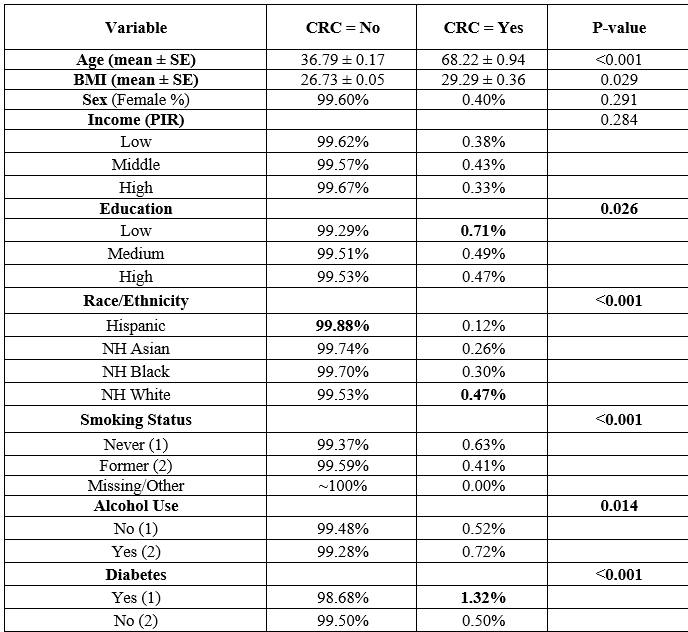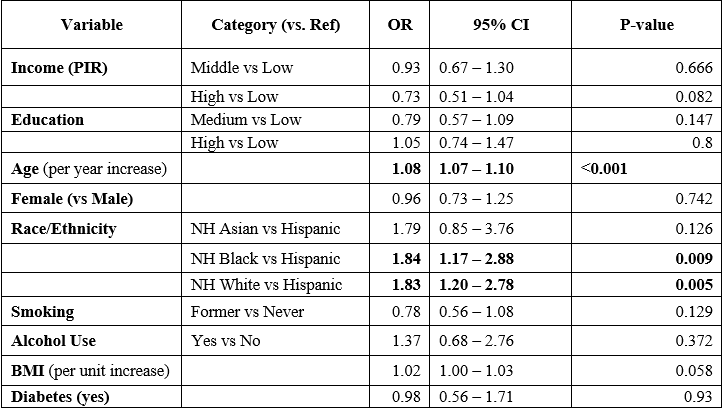Tuesday Poster Session
Category: Colorectal Cancer Prevention
P4765 - Racial Disparities but Not Socioeconomic Status Predict Colorectal Cancer Risk in a Nationally Representative US Population
Tuesday, October 28, 2025
10:30 AM - 4:00 PM PDT
Location: Exhibit Hall
- OK
Omar Khattab, MD
Kettering Health Netwrok, CA
Presenting Author(s)
Omar Khattab, MD1, Frhaan Zahrawi, MBBCh2, Mohamed Alharami, MD3, Raneem Khattab, MD4, Aya Alshorbaji Almazayek, MS5, Hadi Hemaidan, MS6
1Kettering Health Netwrok, Kettering, OH; 2Franciscan Health Olympia Fields, Olympia Fields, IL; 3Henry Ford Warren, Warren, MI; 4Baylor University, Dallas, TX; 5Damascus University, Damascus, Dimashq, Syria; 6Florida International University, Daytona Beach, FL
Introduction: The United States experiences colorectal cancer (CRC) as one of its leading cancer contributors. The relationship between socioeconomic status (SES) and cancer risk remains uncertain because its independent impact is not clearly defined. The study assessed socioeconomic status effects on colorectal cancer occurrence by analyzing National Health and Nutrition Examination Survey (NHANES) data for racial and ethnic population groups.
Methods: The study utilized NHANES data from 1999 through 2020. The measurement of SES incorporated two indicators which included educational level (low, medium, high) together with income-to-poverty ratio categories (low < 2, middle 2-4, high >4). Self-reported CRC diagnosis served as the primary research outcome. The analysis used logistic regression models with survey design weights to calculate odds ratios (ORs) and their corresponding 95% confidence intervals (CIs) while adjusting for age, sex, race/ethnicity, body mass index (BMI), smoking, alcohol use and diabetes. The complex sampling design of NHANES required application of survey weights together with strata variables and primary sampling units for all analyses.
Results: The analysis of 111,222 participants (427 cases of CRC) found no significant relationship between income or education level and CRC risk when risk models were fully adjusted. The study maintained racial/ethnic disparities because non-Hispanic Black people had an 84% increased CRC risk (OR 1.84, 95% CI 1.17-2.88, p=0.009) and non-Hispanic Whites had an 83% increased CRC risk (OR 1.83, 95% CI 1.20-2.78, p=0.005) when compared to Hispanic participants. Age functioned as a crucial factor for CRC risk (OR per year 1.08, 95% CI 1.07-1.10, p < 0.001). BMI showed a minor association with increased CRC risk with an OR of 1.02 for each unit increase but the association did not reach statistical significance (p=0.058).
Discussion: This research demonstrated that SES did not independently affect CRC risk among a large population sample when controlling for age, gender and health factors. The study demonstrated significant racial and ethnic differences because non-Hispanic Black and non-Hispanic White people had double the risk of developing CRC when compared to Hispanics. The findings demonstrate that initiatives for CRC screening and prevention must be specifically designed to combat racial disparities instead of focusing on socioeconomic status alone.

Figure: Survey-Weighted Descriptive Characteristics by Colorectal Cancer (CRC) status. All proportions are row percentages. Means are survey-weighted with standard errors. Bold p-values indicate statistically significant differences (p < 0.05)

Figure: Fully Adjusted Odds Ratios for Colorectal Cancer
Disclosures:
Omar Khattab indicated no relevant financial relationships.
Frhaan Zahrawi indicated no relevant financial relationships.
Mohamed Alharami indicated no relevant financial relationships.
Raneem Khattab indicated no relevant financial relationships.
Aya Alshorbaji Almazayek indicated no relevant financial relationships.
Hadi Hemaidan indicated no relevant financial relationships.
Omar Khattab, MD1, Frhaan Zahrawi, MBBCh2, Mohamed Alharami, MD3, Raneem Khattab, MD4, Aya Alshorbaji Almazayek, MS5, Hadi Hemaidan, MS6. P4765 - Racial Disparities but Not Socioeconomic Status Predict Colorectal Cancer Risk in a Nationally Representative US Population, ACG 2025 Annual Scientific Meeting Abstracts. Phoenix, AZ: American College of Gastroenterology.
1Kettering Health Netwrok, Kettering, OH; 2Franciscan Health Olympia Fields, Olympia Fields, IL; 3Henry Ford Warren, Warren, MI; 4Baylor University, Dallas, TX; 5Damascus University, Damascus, Dimashq, Syria; 6Florida International University, Daytona Beach, FL
Introduction: The United States experiences colorectal cancer (CRC) as one of its leading cancer contributors. The relationship between socioeconomic status (SES) and cancer risk remains uncertain because its independent impact is not clearly defined. The study assessed socioeconomic status effects on colorectal cancer occurrence by analyzing National Health and Nutrition Examination Survey (NHANES) data for racial and ethnic population groups.
Methods: The study utilized NHANES data from 1999 through 2020. The measurement of SES incorporated two indicators which included educational level (low, medium, high) together with income-to-poverty ratio categories (low < 2, middle 2-4, high >4). Self-reported CRC diagnosis served as the primary research outcome. The analysis used logistic regression models with survey design weights to calculate odds ratios (ORs) and their corresponding 95% confidence intervals (CIs) while adjusting for age, sex, race/ethnicity, body mass index (BMI), smoking, alcohol use and diabetes. The complex sampling design of NHANES required application of survey weights together with strata variables and primary sampling units for all analyses.
Results: The analysis of 111,222 participants (427 cases of CRC) found no significant relationship between income or education level and CRC risk when risk models were fully adjusted. The study maintained racial/ethnic disparities because non-Hispanic Black people had an 84% increased CRC risk (OR 1.84, 95% CI 1.17-2.88, p=0.009) and non-Hispanic Whites had an 83% increased CRC risk (OR 1.83, 95% CI 1.20-2.78, p=0.005) when compared to Hispanic participants. Age functioned as a crucial factor for CRC risk (OR per year 1.08, 95% CI 1.07-1.10, p < 0.001). BMI showed a minor association with increased CRC risk with an OR of 1.02 for each unit increase but the association did not reach statistical significance (p=0.058).
Discussion: This research demonstrated that SES did not independently affect CRC risk among a large population sample when controlling for age, gender and health factors. The study demonstrated significant racial and ethnic differences because non-Hispanic Black and non-Hispanic White people had double the risk of developing CRC when compared to Hispanics. The findings demonstrate that initiatives for CRC screening and prevention must be specifically designed to combat racial disparities instead of focusing on socioeconomic status alone.

Figure: Survey-Weighted Descriptive Characteristics by Colorectal Cancer (CRC) status. All proportions are row percentages. Means are survey-weighted with standard errors. Bold p-values indicate statistically significant differences (p < 0.05)

Figure: Fully Adjusted Odds Ratios for Colorectal Cancer
Disclosures:
Omar Khattab indicated no relevant financial relationships.
Frhaan Zahrawi indicated no relevant financial relationships.
Mohamed Alharami indicated no relevant financial relationships.
Raneem Khattab indicated no relevant financial relationships.
Aya Alshorbaji Almazayek indicated no relevant financial relationships.
Hadi Hemaidan indicated no relevant financial relationships.
Omar Khattab, MD1, Frhaan Zahrawi, MBBCh2, Mohamed Alharami, MD3, Raneem Khattab, MD4, Aya Alshorbaji Almazayek, MS5, Hadi Hemaidan, MS6. P4765 - Racial Disparities but Not Socioeconomic Status Predict Colorectal Cancer Risk in a Nationally Representative US Population, ACG 2025 Annual Scientific Meeting Abstracts. Phoenix, AZ: American College of Gastroenterology.
